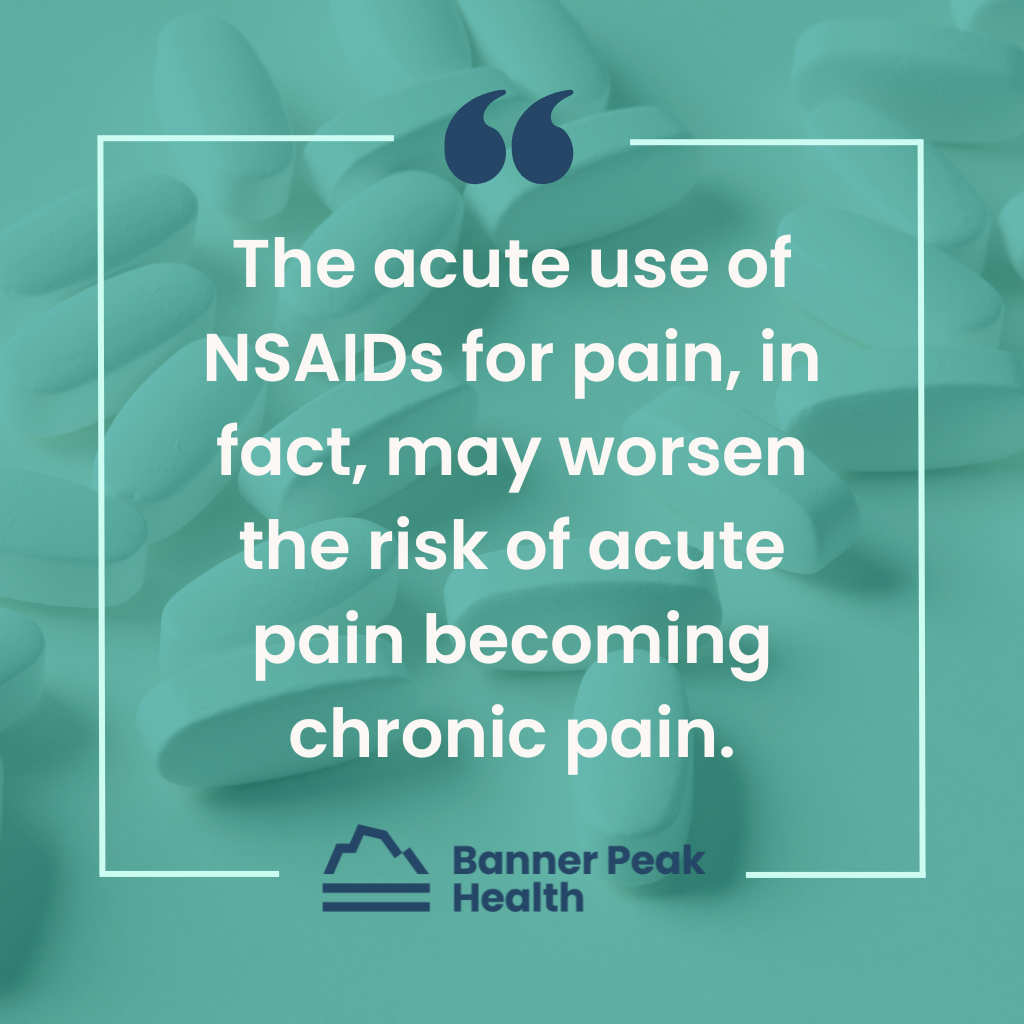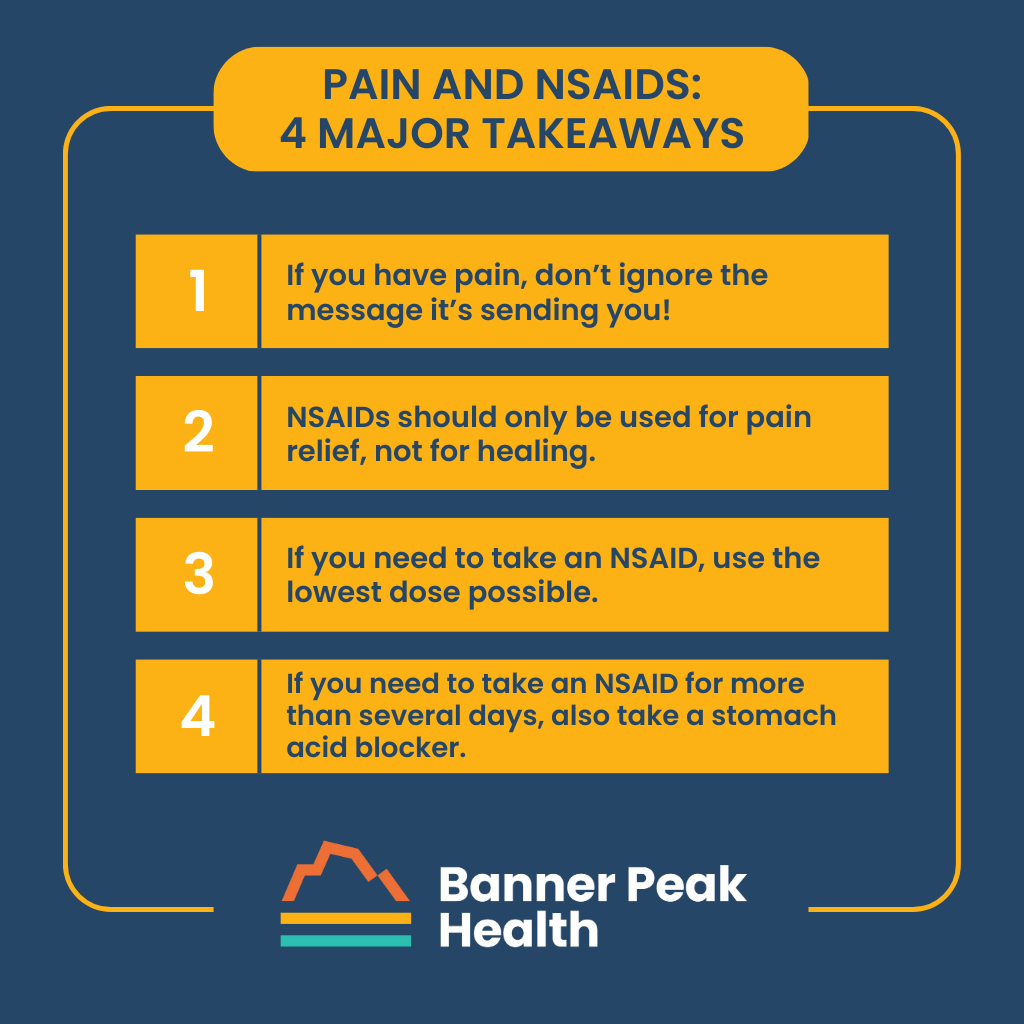The medical community may be at an inflection point in how we think about nonsteroidal anti-inflammatory drugs. I’ve always been skeptical of their risk/benefit ratio, and I’m excited to see a growing body of medical literature supporting my position.
You’ve likely heard the acronym NSAID: nonsteroidal anti-inflammatory drug. NSAIDs work by blocking an important biochemical pathway, which reduces inflammation in the body.
NSAIDs are known by both brand and generic names: Motrin and Advil (ibuprofen), Aleve (naproxen), and Voltaren (diclofenac) are among the most common. We use them to reduce inflammation — more plainly, to reduce the pain associated with inflammation.
I believe any discussion about NSAIDs as pain treatment has to begin with the fundamentals of pain. From a medical perspective, we’ve gotten into the habit of thinking pain is universally bad; something that must be pharmacologically stamped out.
But pain serves a very real purpose. As humans, we’ve evolved to have an exquisitely nuanced and sensitive pain system.
From a simple but effective signal that the pan on the stove is hot and you need to let go of it immediately, to shin pain as you jog that warns you to alter your stride to avoid further injury, pain is useful. It’s an unmistakable communication that our connection to the environment needs to be modified. Our approach to pain relief needs to take this useful communication into account.
Yes, pain can be terribly destructive, but as we discuss NSAIDs, we need to keep an open mind about pain and why it exists in the first place.
Why Are NSAIDs So Popular?
Why are NSAIDs so popular? I’d say it’s because they occupy a sweet spot on the spectrum of pain-relieving drugs.
Tylenol (acetaminophen), when taken at recommended dosages, has very few side effects, though taking too much can be very toxic to the liver. However, Tylenol is not a very effective pain relief modality. On the other hand, medications such as glucocorticoids, which reduce inflammation, or narcotics, which blunt the body’s pain response, are much more powerful but have a much more formidable side effect profile.
In the middle of the spectrum are NSAIDs. With their moderate risk-to-benefit ratio, they’re a compromise and obvious first choice for many.
But in spite of their popularity, I believe NSAIDs shouldn’t be so hurriedly grabbed off the shelf.
My Unpopular Take on NSAIDs
We’re beginning to build a body of information that demonstrates that the acute use of NSAIDs for pain, in fact, may worsen the risk of acute pain becoming chronic pain.
There are some preliminary observational studies looking at temporomandibular joint pain and lower back pain, demonstrating that individuals who had taken NSAIDs early on for pain control were at greater risk for these syndromes developing into chronic pain.
The theory is that early inflammation is an adaptive response we’ve evolved to help our bodies heal in a way to prevent chronic pain from developing. By using NSAIDs to block that route of inflammation, we’re increasing our risk of developing chronic pain.
Certain studies conducted on mice look at neutrophils, a prominent component of the inflammatory response. These studies demonstrate that when an early rise in neutrophils is blunted by NSAID administration, mice are at greater risk of developing a chronic pain response.
While these studies are new and haven’t yet undergone large, full-scale, controlled trials, they do point to a truism that evolution exists for a reason. The fact that we’ve evolved pain mechanisms that do this and we’re still here on Earth suggests it’s an adaptive response that we shouldn’t readily block with drug therapy.
It indicates that, indeed, pain has a purpose.
In addition to the conceptual problem of NSAIDs for acute pain interfering with the healing process, nonsteroidal anti-inflammatory drugs also come with a long list of potential side effects which pose a very real risk.
The Side Effects of NSAIDs
Outside of stunting our body’s adaptive responses, nonsteroidal anti-inflammatory drugs are associated with a very long list of significant side effects: upset stomach, bleeding, ulcers, rising blood pressure, swollen legs, kidney impairment, even increased risk of heart attack.
Next time you take a trip to your local pharmacy, read the list of potential side effects printed on your preferred NSAID. You may be quite shocked!
Today’s Takeaways
- If you have pain, don’t ignore the message it’s sending you! Pause and reflect. Ask yourself why you have pain in the first place, and see if you can modify the source.
- NSAIDs should only be used for pain relief, not for healing. We now know they actually interfere with overall healing.
- If you need to take an NSAID, use the lowest dose possible for the shortest period of time needed to experience pain relief.
- If you need to take an NSAID for more than several days, also take a stomach acid blocker such as Pepcid (famotidine) to reduce the risk of upset stomach and ulcers.
BONUS TIP: Diclofenac (brand name Voltaren) is available over the counter (without a prescription) in a topical formulation that works well for joint pain near the skin — such as in the hands and feet — with minimal risk of side effects.

Barry Rotman, MD
For over 30 years in medicine, Dr. Rotman has dedicated himself to excellence. With patients’ health as his top priority, he opened his own concierge medical practice in 2007 to practice medicine in a way that lets him truly serve their best interests.





